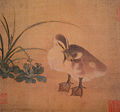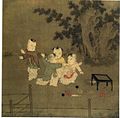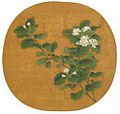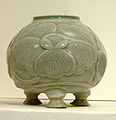用户:小为/MyTaskList/Sandbox1
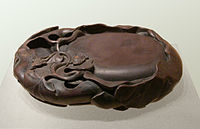
宋朝文化是中国文化历史中的丰盛时期,艺术、音乐、文学、哲学各方面都很有成就。为筛选官员而建立的科举考试推进了教育制度的发展,印刷品的广泛流创促进了文学的交流与对艺术的鉴赏。与唐朝不同,一般的官员都具有学者、诗人、画家、政治家的特质,喜爱字画,善于诗词,收藏古董。一般百姓钟爱戏曲,酒家林立菜式繁多,市场充斥衣服鞋物。
艺术
[编辑]中国画特别是山水画到了宋代发展已经非常成熟。不仅仅把风景描绘,还强调画中意境。道家强调阴阳,宋代理学注重天人合一,追求暗藏在社会与自然之间的义理。[1]自宋代,人们懂得制作半透明的瓷器和混合使用搪瓷的青瓷制品。其中龙泉青瓷在宋代已经非常受欢迎。[2]宋代的黑色和红色漆器都配上以自然山水,历史人物和简单的装饰图案为题材的精美雕刻。譬如黄地剔红后赤壁赋图盘、朱锦地剔黑赤壁赋盘、楼阁人物堆黑盒、醉翁亭朱锦地剔黑盘。[3]虽然铸铜艺术、瓷器艺术、漆器艺术、玉器雕刻、雕塑、建筑、描绘动物的水墨画受到文人高度评价,但是山水画仍然为列最高。[4] 山水画大师掌握了如何构造仔细拟真的近景,并且利用穿插云间的高山流水制造无限的远景。[5]

两宋画风有别。北宋山水画多灿烂辉煌转,质感强烈,时而柔和温雅,气势宏大。在苏轼的提倡下,慢慢走向最求自我表现,追求意境,务求神似。南渡后,多描绘秀丽江南山水景色,构图简约,但花鸟画则更趋严谨精致。[6] This change in attitude from one era to the next stemmed largely from the rising influence of 理学 philosophy. Adherents to 理学 focused on reforming society from the bottom up, not the top down, which can be seen in their efforts to promote small private academies during the Southern Song instead of the large state-controlled academies seen in the Northern Song era.[7]
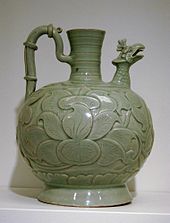
Ever since the Southern and Northern Dynasties (420–589), painting had become an art of high sophistication that was associated with the gentry class as one of their main artistic pastimes, the others being calligraphy and poetry.[8] During the Song Dynasty there were avid art collectors that would often meet in groups to discuss their own paintings, as well as rate those of their colleagues and friends. The poet and statesman 苏轼 (1037–1101) and his accomplice 米芾 (1051–1107) often partook in these affairs, often borrowing art pieces to study and copy, or if they really admired the art piece then a persuasion to make a trade for it was often proposed.[9] The small round paintings popular in the Southern Song were often collected into albums as poets would compose poems to the side to match the theme and mood of the painting.[10]
Although they were avid art collectors, Song scholars did not readily appreciate artworks commissioned by those considered beneath their social class. Anthony J. Barbieri-Low, a Professor of Early Chinese History at the University of California, Santa Barbara, points out that Song scholars' appreciation of art created by their peers was not extended to those who made a living simply as professional artists:[11]
During the Northern Song (960–1126 CE), a new class of scholar-artists emerged who did not possess the tromp l'oiel skills of the academy painters nor even the proficiency of common marketplace painters. The literati's painting was simpler and at times quite unschooled, yet they would criticize these other two groups as mere professionals, since they relied on paid commissions for their livelihood and did not paint merely for enjoyment or self-expression. The scholar-artists considered that painters who concentrated on realistic depictions, who employed a colorful palette, or, worst of all, who accepted monetary payment for their work were no better than butchers or tinkers in the marketplace. They were not to be considered real artists.[11]
Despite this attitude of scholar-officials, talented court painters were highly esteemed by the emperor and royal family. 宋代著名的山水画大师有很多,譬如张择端 (1085–1145), who 他曾绘画著名的《清明河上图》。宋高宗(1127–1162) 曾下令根据汉代女诗人蔡文姬的《胡笳十八拍》作画。自唐末灭佛后,四川的大足石刻象征着佛教在宋代开始复兴。类似大足石刻的雕塑设计有四川名山的安岳石窟。引用错误:<ref>标签有冲突或无效的属性
字画
[编辑]-
毛益于12世纪所绘《蜀葵游猫图》
-
南宋《枇杷山鸟图》,作者不详
-
李安忠《竹鸠图》,12世纪中叶早期绘
-
A duckling, anonymous painter of the Southern Song
-
Palace children playing, Northern or Southern Song
-
郭熙(约1023年—约1085年)于1072年所作《早春图》
-
云南大理国在1173年—1176年间由张胜温等人绘制的《梵像卷》中的释迦佛会,现藏于台北故宫博物院
-
A Scholar in a Meadow, 11th century.
-
宋朝11世纪的孔雀明王画像,现藏于日本京都仁和寺
-
绘于北宋12世纪的《梅竹聚禽图》,作者不详
-
The Trip of the Emperor Minghuang after Shu, 11th century.
-
12世纪初北宋赵昌所绘绢彩《茉莉花图》,现存于中华人民共和国上海博物馆
-
李衎(1244年-1320年)《竹石图》
-
绘于12世纪的《虎溪三笑图》,带有南宋李唐画风
-
黄居采(933-993以后)《山鹧棘雀图》
-
宋仁宗之后郭氏官方绘像
-
陈容《九龙图》卷之一,绘于1244年
-
马麟《静听松风图》,1246年绘
-
易元吉于11世纪所绘《猴猫图》(片段)
-
许道宁于11世纪所绘《松下曳杖图》
-
宋《子母鸡图》,作者不详
陶瓷
[编辑]-
来自景德镇的青白瓷茶壶
-
A cut and engraved sandstone and celadon jar from Yaozhou in Shaanxi, 10th-11th century.
-
北宋青铀陶壶
-
陕西耀州窑青釉瓜楞执壶,于10世纪末烧制
-
南宋来自景德镇的青白瓷器
-
Gray sandstone dish with a celadon coating, decorated with a peony motif, from Yaozhou in Shaanxi, 11th-12th century.
-
A funerary porcelain figurine in the personification of the Chinese zodiac, from Jingdezhen in Jiangxi, 12th century.
-
Celadon plate from Yaozhou in Shaanxi, 10th-11th century.
-
A Song ceramic box with floral medallions
-
配以花朵与龙的造型的白瓷花瓶
-
以莲花衬托的龙泉青瓷
-
一对黑釉兔毫盏
文学与典籍
[编辑]
文学
[编辑]在宋代的中国文学作品种类繁多,派别林立,随着社会发展变得非常繁盛。虽然唐朝早期能以诗被誉为中国文学的高峰,但宋代却能够以词创造另一个高峰。宋代文学人才辈出,有宋代议论先驱梅尧臣,大文豪苏轼,行为疯狂的米芾,首位著名女词人李清照等等。虽然词始于南梁,但到了宋代却大受欢迎,成了宋代文学的主要体裁。政治家范仲淹,理学家欧阳修,书法家黄庭坚,领军文人辛弃疾都是以词著名。
史学
[编辑]史学 in literature remained prominent during the Song, as it had in previous ages and would in successive ages of China. Along with Song Qi, the essayist and historian 欧阳修所负责编纂的《新唐书》在1060年完成。司马光与王安石则担当历史巨著《资治通鉴》的总纂官。 《资治通鉴》记载的历史由周直到五代的后周,横跨16个朝代,共294卷。[13] It covered the major themes and intricate nuances of Chinese history from 425 BC during the Warring States all the way up to the 10th century and the fall of the Tang Dynasty.[14][13] In 1189 it was compiled and condensed into fifty-nine books by 朱熹 (1130–1200), while this project was totally complete with the efforts of his disciples around the time of his death in 1200.[15]
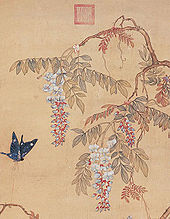

类书
[编辑]宋代有好几本庞大的类书,其中《宋汇部四大书》为最著名,早期参与编纂工作的有李昉和徐铉。及后,《册府元龟》才编入《宋汇部四大书》,其余的就是《太平御览》、《太平广记》及《文苑英华》。除此之外,还有1037年完成的《集韵》。Although 理学 became dominant over Buddhism in China during this period, there was still a significant amount of Buddhist literature. For example, there was the collection of Zen Buddhist kōans in the 碧岩录 Blue Cliff Record of 1125, which was expanded by 北宋的圜悟克勤 Yuanwu Keqin (1063–1135). 游记文学 was also a popular category of literature during the Song period, which was accounts of one's own travel experiences typically written in narrative or prose styles, and included authors such as 范成大.[16] 苏轼的《石钟山记》开展旅游文学。
特别文献
[编辑]宋朝有很多与技术和科学有关的著作面世。其中,两位著名学者有沈括和与他同时期的苏颂。沈括在公元1088年完成了《梦溪笔谈》,其内容十分广泛,包括文学、艺术、军事、数学、天文学、气象学、地质学、地理学、冶金学、工程学、水利学、建筑学、动物学、植物学、农学、医学、人类学、考古学等等。[17] 身为沈括的好友,苏颂不但在公元1070年编写了医药学的重要著作《本草图经》,以梳理植物学、动物学、冶金学及矿物学;还在在公元1092年完成了他天文名著-《新仪象法要》,为他所复制的水运仪象台 作详细的解释。该水运仪象台能够集合天文观察、天象演示、自动报时于一身。[18][19][20][21][22] Although these two figures were perhaps the greatest technical authors in their field during the time, there were many others. For producing textiles, 秦观's book of 1090 AD, the 《蚕书》, included description of a silk-reeling machine that incorporated the earliest known use of the mechanical belt drive in order to function.[23] In the literary field of agronomy, there was the 《救荒活民书》 edited by 董煟 in the 12th century, the 《茶录》 written by 蔡襄 in 1060 AD, the 《朱子社仓法》(Master Zhu on Managing Communal Granaries) written by 朱熹 in 1182 AD, and many others.[24][25] There were also great authors of written works pertaining to geography and cartography during the Song Dynasty, such as 乐史Yue Shi (太平寰宇记 his book in 983), Wang Zhu (in 1051), 李德刍 Li Dechu (in 1080), Chen Kunchen (in 1111), Ouyang Wen (in 1117), and Zhu Mu (in 1240).[26] Although an early form of the local geographic gazetteer existed in China since the 1st century, the matured form known as "treatise on a place", or 方志fangzhi, replaced the old "map guide", or 图经tujing, during the Song Dynasty.[27] The major differences between the two were that 方志fangzhi were products of local initiative and decision-making, were typically ten to fifty chapters in length, and were almost always printed for a large audience, whereas 图经tujing were products of infrequent demands from the central government and were typically only four chapters long.[28] The widespread availability of printing in the Song allowed many ordinary people to access materials that were once read almost exclusively by experts, such as printed texts and handbooks on agriculture, childbirth, pharmacy and medicine, domestic economics, geography, divination, and Daoist rituals.[29][30]
戏曲
[编辑]

中国戏曲可以追朔至唐朝的梨园。可是,历史学家Stephen H. West则确认北宋首都开封是首个真正的表演艺术中心。[31]随着商人与文官的生活及娱乐消费日增,促进了表演艺术与饮食行业的发展。[32]开封内有50多个表演场地,当中有四个可以容纳数千名观众,为附近商店提供大量人流。[33] The chief crowd that gathered was composed of those from the merchant class, while government officials only went to restaurants and attended theatre performances during holidays.[34]
From 开封, the 杂剧dramatic style employed the 北曲style of poetic lyrics.[31] After the capital had shifted to 杭州, the dramatic style of 戏文 (also 南戏 or 南曲) developed separately.[35]这两个不同地方剧种,以不同的方言唱说,以独特角色组别来表演,配以不同类别的中国音乐。[36] In 开封 drama, one singer was preferred for each play, accompanied by string and percussion instruments.[36] In 杭州 drama, there was a multitude of singers on stage for each set, while string and wind instruments were preferred.[36]
Color and clothing distinguished the rank of theatre actors in the Song.[37] Similar to vendors who wore specific outfits to identify which guild they belonged to, actors' generic costumes reflected the role type they played on stage, whether it be student, young man, young woman, official, soldier, etc.[38] Actors honed their theatrical skills at drama schools.[37] Musicians also found work in the theatre industry, since plays performed in the markets were often accompanied by music.[37]台上的演出者会以文言唱说,而白话即口语在元朝以前的戏剧表演中不被接纳。[39] Although trained to speak in the erudite Classical language, acting troupes commonly drew their membership from one of the lowest classes in society: prostitutes.[40] Themes enjoyed in stage skits varied from satires about corrupt officials to comedy acts with titles like "Setting fire when delivering the soup," "Raising a ruckus in the winehouse," "The peony smells best when the wine is stolen," and "Catching a monkey in a restaurant."[41][42] The only xiwen play to have survived from the Southern Song era is the Zhang Xie zhuang yuan (张协状元), featuring interludes such as a clown stealing food and wine at a wedding banquet in act 16 and a quick comedy sketch about renting a room in act 24.[43]
Surprisingly, actors on stage did not have a wholesale monopoly on theatrical entertainment, as even vendors and peddlers in the street, singing lewd songs and beating on whatever they could find to compensate for percussion instruments, could draw crowds.[44] This practice was so widespread that West claims "the city itself was turned into a stage and the citizens into the essential audience."[45] Many of the songs played for stage performances were tunes that originated from vendors' and peddlers' songs.[46] Contests were held on 元旦 to determine which vendor or peddler had the best chants and songs while selling wares; the winners were brought before the imperial court to perform.[45] The 武林记事Wulin jiushi of the Southern Song states that these vendors, when presented to the consorts and concubines of the palace, were lavished with heaps of gold and pearls for their wares; some vendors would "become rich in a single evening."[38] Theatrical stunts were also performed to gain attention, such as fried-glutinous-rice-ball vendors hanging small red lamps on portable bamboo racks who would twirl them around to the beat of a drum to dazzle crowds.[47] Puppet shows in the streets and wards were also popular.[38]
习俗
[编辑]节日
[编辑]
In ancient China there were many domestic and public pleasures in the rich urban environment unique to the Song Dynasty. For the austere and laborious peasantry, annual festivals and holidays provided a time of joy and relaxation, and for the poorest it meant a chance to borrow food and alcoholic drink so that everyone could join in the celebration.[48] People would gather around their local sanctuary to observe the festival's games, theatrical entertainments, juggling, clowning, and other performances.[48] The fesitivities on 春节 were considered the most important of the year by the Chinese, its momentous occasion correlating with the beginning of February on the Western calendar.[48] Preparations for the New Years festival took place over a month's time, as people busied themselves painting door gods, crafting paper streamers with lucky characters for "welcoming the spring," making printed images of Zhong Kui, and cooking special kinds of foods such as porridge of red haricot beans.[49] 在正月十五举行的元宵节,又称灯节,非常受欢迎。百姓制作花灯,欣赏花灯,猜灯谜,赏灯持续五天。宋孝宗时期,根据周密所说,最好的灯节都在苏州和福州,而杭州的灯样式繁复多样,辛弃疾曾写道:“东风夜放花千树,更吹落,星如雨”。[50] Written in his memoirs, 孟元老 (active 1126-1147) recalled how the earlier Northern Song capital at 开封 would host festivals with tens of thousands of colorful and brightly-lit paper lanterns hoisted on long poles up and down the main street, the poles also wrapped in colorful silk with numerous dramatic paper figures flying in the wind like fairies.[50] There were also other venerated holidays, such as the 清明节, as it was supposedly this period of the year that was depicted in the artwork (mentioned above) by the artist 张择端 (although some would argue the painting actually represented the time of autumn in the year).

With the advent of the discovery of 火药 in China, lavish 烟花 displays could also be held during festivities. For example, the martial demonstration in 1110 AD to entertain the court of 宋徽宗, when it was recorded that a large fireworks display was held alongside Chinese dancers in strange costumes moving through clouds of colored smoke in their performance.[52] The common people also purchased 鞭炮s from city shopkeepers and vendors, made of simple sticks of bamboo filled with a small amount of gunpowder.[49]
Although they were discontinued after the devastation of the 安史之乱 (755–763) during the 唐朝, lavish Chinese carnivals were revived and once again celebrated during the Song Dynasty.[53] Nationwide Chinese carnival celebrations were held nationwide when the emperor felt a great occasion warranted a grand display of his benevolence and generosity, such as renowned military victories, abundant harvests after long droughts or famines, the granting of grand amnesties by the throne, sacrifices to deities, the installation of a crown prince, marriages within the imperial family, etc.[54]
服饰
[编辑]
宋朝的服饰有很多种类,大多反映了个人的社会地位。[56] 由于缺乏廉价的煤炭,人们在冬天会多穿丝绸或棉袄。[56] The clothing material preferred by the rich was silk, and for special occasions they had silk robes with gold brocade.[57] The clothing material used by the poor was often hempen cloth, but cotton clothes were also used, the latter being most widely available in the south.[57] The types of clothes worn by peasants and commoners were largely uniform in appearance (with color standard of black and white),[58] and so was the case for the upper class and elite. In fact, wealthy and leading members of society followed accepted guidelines and ritual requirements for clothing. In the upper class, each stratified grade in the social hierarchy was distinguished by the color and specific ornamentation of robes, the shape and type of headgear, and even the style of girdle worn.[59] This rigid order was especially so during the beginning of the dynasty. However, the lines of hierarchy slowly began to blur as the color purple, once reserved solely for the attire of third rank officials or higher, began to diffuse amongst all ranks of officials who bore the color indiscriminately.[58] Along with lower grade civil officials in the government protesting the rigid regulations for attire, the wealthy members of the merchant class also contributed to the disintegration of rules for ceremonial attire worn only by certain members of society.[60] Yet there were still visible distinctions between civil officials and the class of rich merchants and business owners; the officials were distinguished by their long robes reaching to the ground, while merchants often wore a blouse that came down below the waist with trousers.[60] Pants and trousers were introduced to China during the Warring States in the 4th century BC, and were not exclusive to merchants;[57] every soldier wore trousers as part of his uniform, while trousers were also worn by the common people.[57] Although most men were cleanshaven, soldiers, military officers, and professional boxing champions preferred side-whiskers and goatee beards, as they were a sign of virility.[55]

The attire of Song women was distinguished from men's clothing by being fastened on the left, not on the right.[60] Women wore long dresses or blouses that came down almost to the knee.[60] They also wore skirts and jackets with short or long sleeves.[60] When strolling about outside and along the road, women of wealthy means chose to wear square purple scarves around their shoulders.[60] Ladies also wore hairpins and combs in their hair, while princesses, imperial concubines, and the wives of officials and wealthy merchants wore head ornaments of gold and silver that were shaped in the form of 凤凰 and flowers.[57]
People in the Song Dynasty never left their homes barefoot, and always had some sort of headgear on.[57] Shops in the city specialized in certain types of hats and headgear, including caps with pointed tails, as well as belts and waistwraps.[61] Only Buddhist monks shaved their heads and strolled about with no headgear or hat of any sort to cover their heads.[57] For footwear, people could purchase leather shoes called 'oiled footwear', wooden sandals, hempen sandals, and the more expensive satin slippers.[57]
饮食
[编辑]
From the Song period, there are many surviving lists of names for entrées and food dishes in customer menus for restaurants and taverns, as well as for feasts at 宴会,节日,and carnivals, and modest dining.[63] Many of the peculiar names for these dishes do not provide clues as to what types of food ingredients were used.[63] However, judging from the listed seasonings they used for these dishes, such as 胡椒,姜,多香果, 酱油, oil, salt, and vinegar, 宋朝菜式与今日中国传统菜式分别不大。[63] Other additional seasonings and ingredients included walnuts, turnips, crushed Chinese cardamon kernels, 花椒, olives, 银杏, 柑桔 zest, and 麻油.[64][47]
Regional differences in culture brought about different types of foods, while in certain areas the cooking traditions of regional cultures blended together; such was the case of 南宋首都杭州.[63] After the mass exodus from the north, people brought 河南-style cooking and foods (popular in the previous 北宋首都开封) to Hangzhou, which was blended with the cooking traditions of 浙江.[63] However, records indicate that already in the Northern Song period, the first capital at 开封 sported restaurants that served southern Chinese cuisine.[63][36] This catered to capital officials whose native provinces were in the southeast, and would have found northern cuisine lacking in sufficient seasoning for their tastes.[63] In fact, texts from the Song era provide the first use of the phrases nanshi, beishi, and chuanfan to refer specifically to northern, southern, and Sichuan cooking, respectively.[36] Many restaurants were known for their specialties; for example, there was one restaurant in Hangzhou that served only iced foods,[65] while some restaurants catered to those who wanted either hot, warm, room temperature, or cold foods.[66] Descendants of those from 开封 owned most of the restaurants found in Hangzhou,[67] but many other regional varieties in foodstuffs and cooking were sponsored by restaurants. This included restaurants catering 川菜 that emphasized use of pimento pepper, dishes and beverages from 河北 and 山东, and coastal foods of shrimp and saltwater fish.[62] The memory and patience of waiters had to be keen; in the larger restaurants, serving dinner parties that required twenty or so dishes became a hassle if even a slight error occurred.[66] If a guest reported the mistake of a waiter to the head of the restaurant, the waiter could be verbally reprimanded, have his salary docked, or in extreme cases, kicked out of the establishment for good.[66]

In the early morning in Hangzhou, along the wide avenue of the Imperial Way, special breakfast items and delicacies were sold.[68] This included fried 内脏,羊肉或者鹅, soups of various kinds, hot pankaces, steamed pancakes, and iced cakes.[68] 中式面店非常受欢迎,在 were also popular, and remained open all day and night along the Imperial Way.[69] According to one Song Dynasty source on 开封, the night markets closed at the third night watch but reopened on the fifth, while they had also gained a reputation for staying open during winter storms and the darkest, rainiest days of winter.[70]
There were also some exotic foreign foods imported to China from abroad, including raisins, dates, Persian jujubes, and grape wine; rice wine was more common in China, a fact noted even by the 13th century 威尼斯 traveler 马可波罗.[71] Although grape-based wine had been known in China since the ancient Han Dynasty Chinese ventured into Hellenistic Central Asia, grape-wine was often reserved for the elite.[62] Besides wine, other beverages included pear juice, 荔枝 fruit juice, honey and ginger drinks, tea, and pawpaw juice.[72][73] Dairy products and farming were foreign concepts to the Chinese, which explains the absence of cheese and milk in their diet.[74] Beef was also rarely eaten, since the bull was an important draft animal.[74] The main consumptionary diet of the lower classes remained rice, pork, and salted fish,[75] while it is known from restaurant dinner menus that the upper classes did not eat dog meat.[75] The rich are known to have consumed an array of different meats, such as chicken, shellfish, fallow deer, hares, 松鸡, 雉, 鹧鸪, 鹌鹑, fox, badger, clam, crab, and many others.[65][70][47] Local freshwater fish from the nearby lake and river were also caught and brought to market,[74] while the West Lake provided geese and duck as well.[75] Common fruits that were consumed included melons, 石榴, 荔枝, 龙眼, 金桔, 枣, Chinese and Japanese quinces, apricots and pears; in the region around Hangzhou alone, there were eleven kinds of apricots and eight different kinds of pears that were produced.[74][76][47] Specialties and combination dishes in the Song period included scented shellfish cooked in rice-wine, geese with apricots, 莲子汤, pimento soup with mussels and fish cooked with plums, sweet soya soup, baked sesame buns stuffed with either sour bean filling or pork tenderloin, mixed vegetable buns, fragrant candied fruit, strips of ginger and fermented beanpaste, jujube-stuffed steamed dumplings, fried chestnuts, salted fermented bean soup, fruit cooked in scented honey, and 'honey crisps' of kneaded and baked honey, flour, mutton fat and pork lard.[77][70][78][79][47] Dessert molds of oiled flour and sugared honey were shaped into girls' faces or statuettes of soldiers with full armor like door guards, and were called "likeness foods" (guoshi).[80]
宗教与哲学
[编辑]
宋代的学者不断重新诠释传统儒家经典中的真理。这个时期正是佛教作为外来宗教冲击中国思想,并且为学者的一些实际问题提供解决的方法。可是,中国的佛教也同时慢慢吸收了儒家和道家思想。The continuing popularity of Buddhism can be seen with strong evidence by achievements in the arts, such as the 100 painting set of the 五百罗汉, completed by Lin Tinggui and Zhou Jichang in 1178.
The conservative Confucian movement could be seen before the likes of 朱熹 (1130–1200), with staunch anti-Buddhists such as 欧阳修 (1007–1072). In his written work of the Ben-lun, 他指出佛教如何在南北朝已经开始渗入中国的文化。He argued that Buddhism became widely accepted when China's traditional institutions were weakened at the time. This was due to many factors, such as foreign外族鲜卑统治北方,and China's political schism that caused warfare and other ills. 虽然隋文帝废除九品中正制,建立科举制,但也大兴佛教。因此导致佛教在隋唐时期有很大的影响力。历史学家Arthur Wright形容当时的儒家恢复到拟古主义。[81] Ouyang Xiu wrote:
佛法为中国患千余岁,世之卓然不惑而有力者,莫不欲去之。已尝去矣,而复大集:攻之暂破而愈坚,扑之未灭而愈炽,遂至于无可奈何。是果不可去邪?盖亦未知其方也。[82][83]
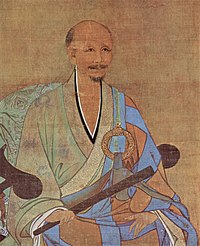
In conclusion on how to root out the 'evil' that was Buddhism, Ouyang Xiu presented a historical example of how it could be uprooted from Chinese culture:
昔战国之时,杨、墨交乱,孟子患之而专言仁义,故仁义之说胜,则杨、墨之学废。汉之时,百家并兴,董生患之而退修孔氏,故孔氏之道明而百家息。此所谓修其本以胜之之效也。[82][84]
Although Confucianism was cast in stark contrast to the perceived alien and morally-inept Buddhism by those such as Ouyang Xiu, Confucianism nonetheless borrowed ideals of Buddhism to provide for its own revival. From Mahayana Buddhism, the Bodhisattva ideal of ethical universalism with benevolent charity and relief to those in need inspired those such as Fan Zhongyan and Wang Anshi, along with the Song government.[85] In contrast to the earlier heavily Buddhist Tang period, where wealthy and pious Buddhist families and Buddhist temples handled much of the charity and alms to the poor, the Song Dynasty government took on this ideal role instead, through its various programs of welfare and charity (refer to Society section).[86] In addition, the historian Arthur F. Wright notes this situation during the Song period, with philosophical nativism taking from Buddhism its earlier benevolent role:
It is true that Buddhist monks were given official appointments as managers of many of these enterprises, but the initiative came from 理学 officials. In a sense the Buddhist idea of compassion and many of the measures developed for its practical expression had been appropriated by the Chinese state.[87]

Although Buddhism lost its prominence in the elite circles and government sponsorships of Chinese society, this did not mean the disappeance of Buddhism from Chinese culture. Zen Buddhism continued to flourish during the Song period, as Emperor Lizong of Song had the monk Wuzhun Shifan share the Chán (Zen) doctrine with the imperial court. Much like the Eastern Roman Emperor Julian the Apostate promoting Roman paganism and Theurgy amongst the leading members of Roman society while pushing Christianity's influence into the lower classes, so too did 理学 of the 13th century succeed in driving Buddhism out of the higher echelons of Chinese society.[88]
In terms of Buddhist metaphysics, the latter influenced the beliefs and teachings of Northern Song-era Confucian scholars such a程颢和程颐 Cheng Hao and Cheng Yi (who were brothers), the former being one of the tutors of 朱熹. They emphasized moral self-cultivation over service to the ruler of the state (healing society's ills from the bottom-up, not the top-down), as opposed to statesmen like Fan Zhongyan or 苏轼, who pursued their agenda to advise the ruler to make the best decisions for the common good of all.[89] The Cheng brothers also taught that the workings of nature and metaphysics could be taught through the principle (li) and the vital energy (qi). The principle of nature could be moral or physical, such as the principle of marriage being moral, while the principle of trees is physical. Yet for principles to exist and function normally, there would have to be substance as well as vital energy.[89] This allowed Song intellectuals to validate the teachings of Mencius on the innate goodness of human nature, while at the same time providing an explanation for human wrongdoing.[89] In essence, the principle underlying a human being is good and benevolent, but vital energy has the potential to go astray and be corrupted, giving rise to selfish impulses and all other negative human traits.

The Song 理学 philosophers, finding a certain purity in the originality of the ancient classical texts, wrote commentaries on them. The most influential of these philosophers was 朱熹, whose synthesis of Confucian thought and Buddhist, Taoist, and other ideas became the official imperial ideology from late Song times to the late 19th century. The basis of his teaching was influenced by the Cheng brothers, but he greatly extended their teachings, forming the core of 理学. This included emphasis on the 四书: the 《论语》, 《孟子》, 《中庸》, and the 《大学》 (the latter two being chapters in the ancient 礼记). His viewpoint was that improvement of the world began with improvement of the mind, as outlined in the Great Learning.[90] His approach to Confucianism was shunned by his contemporaries, as his writings were forbidden to be cited by students taking the Imperial Examinations. However, 宋理宗 found his writing to be intriguing, reversing the policy against him, and making it a requirement for students to study his commentaries on the 四书.[90]
朱熹's 理学 philosophy evolved into a rigid official creed, which stressed the one-sided obligations of obedience and compliance of subject to ruler, child to father, wife to husband, and younger brother to elder brother. The effect was to inhibit the societal development of pre-modern China, resulting both in many generations of political, social, and spiritual stability and in a slowness of cultural and institutional change up to the 19th century. 理学 doctrines also came to play the dominant role in the intellectual life of Korea, Vietnam, and Japan until modern times.
参见
[编辑]注解
[编辑]- ^ Ebrey, Cambridge Illustrated History of China, 162.
- ^ 宋代龍泉青瓷鑒別. 华夏经纬网. 2007-02-09 [2009-11-10].
- ^ 七千年的光辉历程. 江苏文化网. 2006-4-5 [2009-11-10].
- ^ Morton, 104.
- ^ Morton, 105.
- ^ 全面發展的宋金遼繪畫. 华夏经纬网. [2009-11-11].
- ^ Walton, 199.
- ^ Ebrey, 81-83.
- ^ Ebrey, 163.
- ^ 引用错误:没有为名为
ebrey cambridge 163的参考文献提供内容 - ^ 11.0 11.1 Barbieri-Low (2007), 39–40.
- ^ 宋 崔白《雙喜圖》. 中国艺术家联盟. 2008-7-14 [200-11-10].
- ^ 13.0 13.1 Pratt & Rutt, 478.
- ^ Brownlee, 19.
- ^ Partington, 238.
- ^ Hargett, 67-68.
- ^ Needham, Volume 1, 136.
- ^ Sivin, III, 32.
- ^ Needham, Volume 3, 208 & 278.
- ^ Wu, 5.
- ^ Needham, Volume 4, Part 2, 445–448.
- ^ Bodde, 140.
- ^ Needham, Volume 4, Part 2, 107-108.
- ^ Needham, Volume 6, Part 2, 621.
- ^ Needham, Volume 6, Part 2, 623.
- ^ Needham, Volume 3, 521.
- ^ Bol, 44.
- ^ Bol, 46.
- ^ Ebrey, Cambridge Illustrated History of China, 158.
- ^ Hymes, 3.
- ^ 31.0 31.1 West, 69.
- ^ West, 69 & 74.
- ^ West, 76.
- ^ West, 98.
- ^ West, 69–70.
- ^ 36.0 36.1 36.2 36.3 36.4 West, 70.
- ^ 37.0 37.1 37.2 Gernet, 223.
- ^ 38.0 38.1 38.2 West, 87.
- ^ Rossabi, 162.
- ^ West, 72.
- ^ West, 78–79.
- ^ Gernet, 224.
- ^ West, 79.
- ^ West, 83–85
- ^ 45.0 45.1 West, 85.
- ^ West, 91.
- ^ 47.0 47.1 47.2 47.3 47.4 West, 86.
- ^ 48.0 48.1 48.2 Gernet, 106.
- ^ 49.0 49.1 Gernet, 186.
- ^ 50.0 50.1 Needham, Volume 4, Part 1, 128.
- ^ Ebrey, Cambridge Illustrated History of China, 148.
- ^ Kelly, 2.
- ^ Benn, 157.
- ^ Benn, 154-155.
- ^ 55.0 55.1 Gernet, 131.
- ^ 56.0 56.1 Gernet, 127.
- ^ 57.0 57.1 57.2 57.3 57.4 57.5 57.6 57.7 Gernet, 130.
- ^ 58.0 58.1 Gernet, 128.
- ^ Gernet, 127–128.
- ^ 60.0 60.1 60.2 60.3 60.4 60.5 Gernet, 129.
- ^ West, 71.
- ^ 62.0 62.1 62.2 Gernet, 134.
- ^ 63.0 63.1 63.2 63.3 63.4 63.5 63.6 Gernet, 133.
- ^ West, 73, footnote 17.
- ^ 65.0 65.1 Gernet, 137.
- ^ 66.0 66.1 66.2 West, 93.
- ^ Gernet, 133–134
- ^ 68.0 68.1 Gernet, 183–184
- ^ Gernet, 184.
- ^ 70.0 70.1 70.2 West, 73.
- ^ Gernet, 134–135.
- ^ Gernet, 138.
- ^ Gernet, 184–185.
- ^ 74.0 74.1 74.2 74.3 Gernet, 135.
- ^ 75.0 75.1 75.2 Gernet, 136.
- ^ West, 73–74.
- ^ Rossabi, 78.
- ^ West, 75.
- ^ West, 75, footnote 25.
- ^ West, 89.
- ^ Wright, 92.
- ^ 82.0 82.1 见欧阳修《本论 中》
- ^ Wright, 88.
- ^ Wright, 89.
- ^ Wright, 93.
- ^ Wright, 93-94.
- ^ Wright, 94.
- ^ Brown, 93.
- ^ 89.0 89.1 89.2 Ebrey et al., 168.
- ^ 90.0 90.1 Ebrey et al., 169.
参考资料
[编辑]- Barbieri-Low, Anthony J. (2007). Artisans in Early Imperial China. Seattle & London: University of Washington Press. ISBN 0295987138.
- Benn, Charles. 2002. China's Golden Age: Everyday Life in the Tang Dynasty. Oxford University Press. ISBN 0-19-517665-0.
- Bodde, Derk (1991). Chinese Thought, Society, and Science. Honolulu: University of Hawaii Press.
- Bol, Peter K. "The Rise of Local History: History, Geography, and Culture in Southern Song and Yuan Wuzhou," Harvard Journal of Asiatic Studies (Volume 61, Number 1, 2001): 37–76.
- Brown, Peter (1971). The World of Late Antiquity. New York: W.W. Norton Inc.
- Brownlee, John S. (1997). Japanese Historians and the National Myths, 1600–1945: The Age of the Gods and Emperor Jinmu. Vancouver: UBC Press. ISBN 0774806451.
- Ebrey, Walthall, Palais, (2006). East Asia: A Cultural, Social, and Political History. Boston: Houghton Mifflin Company. ISBN 0-618-13384-4.
- Ebrey, Patricia Buckley (1999). The Cambridge Illustrated History of China. Cambridge: Cambridge University Press. ISBN 0-521-43519-6 (hardback); ISBN 0-521-66991-X (paperback).
- Gernet, Jacques (1962). Daily Life in China on the Eve of the Mongol Invasion, 1250-1276. Translated by H. M. Wright. Stanford: Stanford University Press. ISBN 0-8047-0720-0
- Hargett, James M. "Some Preliminary Remarks on the Travel Records of the Song Dynasty (960-1279)," Chinese Literature: Essays, Articles, Reviews (CLEAR) (July 1985): 67-93.
- Hymes, Robert P. (1986). Statesmen and Gentlemen: The Elite of Fu-Chou, Chiang-Hsi, in Northern and Southern Sung. Cambridge: Cambridge University Press. ISBN 0521306310.
- Kelly, Jack (2004). Gunpowder: Alchemy, Bombards, and Pyrotechnics: The History of the Explosive that Changed the World. New York: Basic Books, Perseus Books Group.
- Morton, Scott and Charlton Lewis (2005). China: Its History and Culture: Fourth Edition. New York: McGraw-Hill, Inc.
- Needham, Joseph (1986). Science and Civilization in China: Volume 1, Introductory Orientations. Taipei: Caves Books Ltd.
- Needham, Joseph (1986). Science and Civilization in China: Volume 3, Mathematics and the Sciences of the Heavens and the Earth. Taipei: Caves Books Ltd.
- Needham, Joseph (1986). Science and Civilization in China: Volume 4, Physics and Physical Technology, Part 1, Physics. Taipei: Caves Books, Ltd.
- Needham, Joseph (1986). Science and Civilization in China: Volume 4, Physics and Physical Technoogy, Part 2, Mechanical Engineering. Taipei: Caves Books Ltd.
- Needham, Joseph (1986). Science and Civilization: Volume 6, Biology and Biological Technology, Part 2, Agriculture. Taipei: Caves Books Ltd.
- Partington, James Riddick (1960). A History of Greek Fire and Gunpowder. Cambridge: W. Heffer & Sons Ltd.
- Pratt, Keith L. and Richard Rutt. (1999). Korea: A Historical and Cultural Dictionary. Surrey: Curzon Press. ISBN 0700704639.
- Rossabi, Morris (1988). Khubilai Khan: His Life and Times. Berkeley: University of California Press. ISBN 0-520-05913-1.
- Sivin, Nathan (1995). Science in Ancient China: Researches and Reflections. Brookfield, Vermont: VARIORUM, Ashgate Publishing.
- Sorensen, Henrik H. 1995. "Buddhist Sculptures from the Song Dynasty at Mingshan Temple in Anyue, Sichuan," Artibus Asiae (Vol. LV, 3/4, 1995): 281-302.
- Walton, Linda (1999). Academies and Society in Southern Sung China. Honolulu: University of Hawaii Press.
- West, Stephen H. "Playing With Food: Performance, Food, and The Aesthetics of Artificiality in The Sung and Yuan," Harvard Journal of Asiatic Studies (Volume 57, Number 1, 1997): 67–106.
- Wright, Arthur F. (1959). Buddhism in Chinese History. Stanford: Stanford University Press.
- Wu, Jing-nuan (2005). An Illustrated Chinese Materia Medica. New York: Oxford University Press.
延伸阅读
[编辑]- 薛永年. 《中國美術·五代至宋元》. 人民大学出版社. 2004-10-01. ISBN 7300055117.
- 李雨苍. 《宋代陶瓷紋飾精粹繪錄》. 上海古籍出版社. 2004-09-01. ISBN 753253878 请检查
|isbn=值 (帮助). - 李开周. 《食在宋朝:舌尖上的大宋風華》. 花城出版社. 2009-1-1. ISBN 7536055536.

![宋朝崔白《双喜图》[12]](http://upload.wikimedia.org/wikipedia/commons/thumb/2/29/Cui_Bai_-_Magpies_and_Hare.jpg/64px-Cui_Bai_-_Magpies_and_Hare.jpg)





